
 |
|||||
|
|
|||||
|
|
|
|||||
|
|
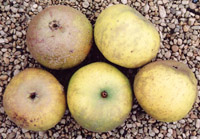 |
DUKE OF DEVONSHIRE Also called Allspice. A late dessert apple raised by Mr Wilson, the Duke of Devonshire's head gardener, at Holker Hall, Lancashire, in 1835. The medium sized fruit has an attractive golden skin and russeting. A good, crisp eater when straight from the tree, but best left to mature until Christmas or later when the fruit has a warm, rich flavour. It reached its peak of popularity in the early 20th century. Stores until March. Pollination Group 4 |
||
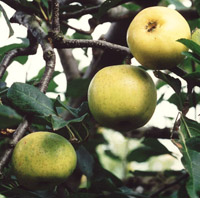 |
DUMELOW'S SEEDLING Also once called Wellington and sometimes now called Dummellor’s Seedling. It was raised in the late 18th century by Richard Dumelow, or Dummeller, a farmer from Shakerstone, Leics, and eventually exhibited at the R.H.S. shows in 1818 as Dumelow's Seedling. It was possibly bred from Northern Greening. It was subsequently renamed Wellington, now reverting to its prior name. Rich, crisp, cream flesh, which cooks to a strongly flavoured purée, similar to a Bramley but creamier in texture. It welcomes some added sugar. It was once grown especially for the mincemeat trade, but was also excellent when baked. It was said to be Queen Victoria's favourite apple and was used as a May Day apple in the North because it stored very well. Spreading trees, with good blossom. Free spur bearing. Pollination Group 5 |
|||
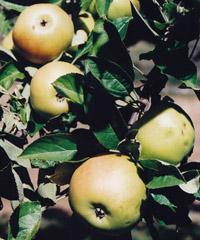 |
DUNN’S
SEEDLING An Australian apple that first arrived in Britain in
1890. It was said to have been raised at Kew near Melbourne by Mr Condor
and introduced by Mr Munroe. A medium sized, late dessert apple, ripe
in October and storing to February. It can sometimes be large. The pale
yellow apples sometimes have a pink flush. The flesh is crisp and white
with a sweet subacid flavour. It is best planted in the south, as it fails
to reach its full potential in colder areas. Pollination Group 4 |
|||
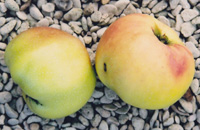 |
DUQUESNE
(Pronounced Do-Cane) The Caledonian Horticultural Society tour of the
Low Countries and Northern France, 1817 (the report published in 1823),
said “Besides the pears, Mr Van Mons sent cions (sic) of more than
thirty kinds of apples, from young trees raised from the seed, most of
them by himself, in the same manner as the pear-trees. All of these he
considers as of good or highly promising qualities, and several of them
as likely to be well adapted to the climate of Scotland.” The names
were listed in the report –page 313, this one as Pepin Duquesne.
The scions were well packed in moss and arrived safely and in good condition.
They were sent to the nurseries of Messrs Dickson and Co. at Leith Walk
and to Messrs Dicksons Brothers at Broughton. Two or three were grafted
of each variety. A year later it was listed by Diel in Germany, as Peppin
Duquesne (1818). Whether Van Mons bred it or just passed it on is unclear.
In ‘The Orchardist’ of 1873, written by John Scott at Merriott,
Somerset, he described it as small, of top quality, in use from November
to April and “a new French apple”. He probably obtained it
from Leroy at Angers, France, where he obtained many apples. The only
full description is from Leroy in his ‘Dictionnaire de Pomologie’
of 1873. Medium sized, longish round to truncate conic. The stalk is of
medium length and thickness, often arched. The eye is large or medium,
open or half closed, in a basin of modest depth, plaited at the edges.
The skin is smooth, bright yellow, washed with rose pink, streaked with
carmine, which is deeper in the sun and with brown around the eye and
a little on the body. The flesh is yellowish white, fine and quite tender,
juicy, sweet, lightly acidulated and with an exquisite perfume. He considered
in of top quality and ripe from January to May. This apple is probably
the same as the ‘Duquesnay’, listed in the 1831 and 1842 collection
catalogues of the London Horticultural Society. In 1895, a list of plantings
at the Luxembourg Gardens in Paris, listed a Calville Duquesne. It seems
to have disappeared entirely from Europe and was unknown in North America.
We discovered it listed in the former Grove Heritage Collection in Tasmania,
and received scions from there in 2010. After a few years of observation,
after it first fruited, it seems to be fully in accord with Leroy’s
description, although the size can be large on a young tree. The apples
ripen in late October or November. The flesh is fine and can be melting
but is crisp, juicy and quite sweet, with a hint of orange. It is not
too sharp to enjoy as a refreshing eating apple with a delicate flavour.
It cooks quite slowly but softens and keeps most of its shape, becoming
richer and tangy. The hint of orange has changed to lemon. Adding a little
sugar improves it further in cooler years but in hot years is very sweet
without sugar. It seems to vary in several ways with the year’s
climate. Pollination Group 4 |
|||
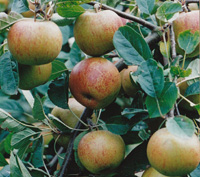 |
DUTCH
MIGNONNE Introduced to England by Thomas Harvey of Catton, near
Norwich, around 1771. He obtained his scion wood from Holland, and as
the name of the apple was not known he called it ‘Dutch Mignonne’.
It is sometimes said to have been of German origin, and Lindley said it
was popular all over Europe. A late-season, dual-purpose apple, with medium-sized
fruit, roundish in shape but lightly ribbed around the eye. The skin is
greenish-yellow, streaked and blushed light red and speckled with russet
dots, especially around the eye. The flesh is crisp, very juicy, sweet
and aromatic, with a rich flavour. The tree is free-spurring, so is good
for training as an espalier or cordon. Heavy crops, which keep to March.
Pollination Group 3 |
|||
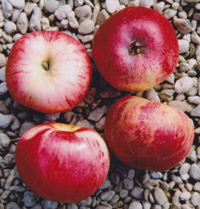 |
DYMOCK
RED According to Hogg and Bull (1886) in ‘The Apple and
Pear as Vintage Fruits’, this cider apple dates from the time of
John Evelyn (1670s), bearing a high reputation then and still respected.
They say it was much grown, then, around Ledbury in Herefordshire and
made a rich and excellent cider, whether alone or mixed with other fruit.
They add that the flesh is yellowish, tender and soft, occasionally tinged
with red, slightly sweet and with a pleasant acidity. Dymock is in Gloucestershire,
on the border with Herefordshire. Others have suggested that this apple
is a bittersharp, rather than the bittersweet described by Hogg and Bull
and of the bittersweet nature found by us. In 1810, Forsyth in ‘A
Treatise on the Culture and Management of Fruit Trees’ said “Dimock’s
Red is under the middle size, of a fine red colour, intermixed with a
little yellow on the side from the sun. It is ripe in January, and keeps
till March.” In our modern climate, we find it is best used between
October and November in the southern half of England. We also find the
flesh to be white, rather than yellowish. The small to medium sized apples
are very pretty, with a crimson blush and streaks over most of the apple,
the shaded part being cream. Scott (1872) in ‘The Orchardist’
also considered it a pretty apple and noted that it was an abundant bearer.
The bitterness is actually quite mild and this fades further as the apple
is kept. From October the sweet apples are pleasant to eat. Dymock Red
is still known and grown. Pollination Group 3 |
|||
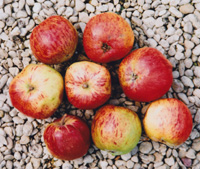 |
EAST
AYTON EARLY In the days before container ships, cold stores and
supermarkets, storing apples from local orchards was vital. Very few apple
varieties would last into May and those that did would be shrunken and
tasteless. It was a serious matter when the earliest new season apples
were some way off. Even more serious was the time when last year’s
cider ran dry. Both cottager and estate needed trees that would produce
apples as early in the year as possible. By common consent, in all the
old literature, these would have been the Joanetings, though the spelling
has changed markedly over the centuries and though they are now called
Joanetings, this is surely a corrupted spelling. Bacon, in the early 17th
century first noted them, but we have no record of the spelling. Gervaise
Markham, in 1613, called them ‘Ieniting’. Parkinson in 1629
had Geneting. Hanmer in 1659 had Janetting. Rea (1665) and Evelyn (1669)
had Juniting. The apple(s) have also been called Jenneting, Juneting and
Juneating. The name Juneating is noteworthy because some authors have
said that they are ripe in June! Rea (1665) says that on a wall they are
ripe in the end of June. Batty Langley, in his Pomona 1727 shows a plate
of an apple labelled ‘Genetting’ and a date alongside of June
1st 1727. Forsyth and others at the start of the 19th century also confirm
the early ripeness, though later writers suggested this was impossible
and that the Joanetings then known only ripened at the end of July. Explanation?
In 1752 Britain (well behind other European countries) changed from the
Julian calendar to the Gregorian calendar. Errors had built up over time,
under the Julian calendar, and corrections had to be made. 11 days were
removed from the calendar to put things back on course. Thus, people went
to bed on the 2nd September and woke to find it was then the 14th September.
Nobody told the apple trees, which kept their own timing to ripeness.
An apple that might have been ripe in late June would now be ripe in July.
Cue Judy Trafford who, in 2018, told us about her mature apple tree with
the fruit ripe in July. That would be very early for any apple in the
Midlands or South of England, but Judy and husband Phil live at East Ayton,
near Scarborough, in North Yorkshire, right against the cold North York
Moors. We wondered whether it could be one of the Joanetings and also
wondered when it would ripen in warmer parts of the country (as yet untested).
Judy sent us the last surviving apples at the start of September 2019
(early apples do not keep for long) and they were not in their full prime
but were still in reasonable condition. Judy reported that they were a
little too soft to be enjoyable for eating raw, and perhaps a little bitter,
but that they made a delicious sauce, breaking down instantly. We did
not find the flavour bitter, but the texture was very melting and soft.
The flavour was fair, sweet and pleasantly acid. We expect the flavour
would have been better a month earlier. Most apples were pale yellow with
red streaks and one which was mostly red had red spots inside the core.
They could not be either Red or White Joaneting. Though the Joanetings
have been thoroughly confused in the old literature, with almost all writers
having something different to say about the naming and which synonyms
applied where; there was one called Early Striped Juneating. This might
be it. Judy and Phil’s house was built in 1952 and Judy has lived
there for 44 years. There were apple trees in neighbours’ gardens
and others in her own, planted in lines not consistent with the newer
houses and gardens. An earlier orchard seems to have had houses built
within. Nearby are farmworkers’ cottages of a much earlier date
and the orchard would likely have been the farm’s orchard, where
early fruiting varieties would have been highly valued. The old orchard
trees have now gone, except two - East Ayton Early (named by Judy) and
one other in her garden. In the 20th century early season apples were
rarely planted. They did not store well and were usually of lesser quality.
The colonies and Europe were beginning to fill the gap with better apples,
available sooner. Farm orchards could and did make different choices.
We wait with keen interest to see the first day of ripening in the South.
In East Ayton, in 2020, the first apples started to fall, without wind
assistance, on the 24th July on the Trafford’s tree. The texture
was soft, not very juicy and not particularly sweet, but lemony and with
a fair flavour. When cooked here they kept their shape, but would mash.
The flavour was lively but not sweet. The apples are strongly fragrant
when gathered. We are grateful to Judy and Phil Trafford for telling us
all about their tree. |
|||
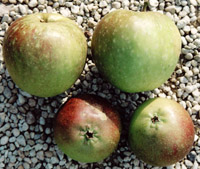 |
EASTER
ORANGE A good dessert apple, still fairly well known, which was
first recorded in 1897 when it was given an RHS Award of Merit. It was
introduced by Hilliers of Winchester. A sweet, aromatic dessert apple
with a golden skin, heavily flushed with darkish red and streaked with
lighter red. There is prominent scaly russet around the stalk and the
body is liberally covered with large pale lenticels. Fruits are medium
sized with juicy, crisp, cream flesh, sweet and well flavoured. It was
called Easter Orange because the fruit stored well until March, though
in our warmer climate it is best before the end of the year, in normal
storage conditions, remaining juicy and crisp. Pollination Group 4 |
|||
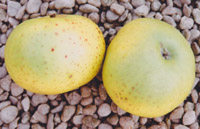 |
ECKLINVILLE
SEEDLING An Irish apple raised by a gardener named Logan, before
1800, at Ecklinville, near Belfast. A popular cooking apple in Ireland
and southern Scotland throughout the 19th century and also often grown
in Worcestershire and other southern counties. The fruit is large with
skin of bright lemon yellow, sometimes with a warm blush, and the tender
flesh breaks down completely when cooked, making a fine sharp apple sauce.
It has also been used as a cider ‘sharp’ or ‘bittersharp’.
At the 1883 National Apple Congress it was rated as one of the twelve
best cooking apples. The trees are good and regular croppers and apples
are ripe and in use from September to November. Pollination Group 4 |
|||
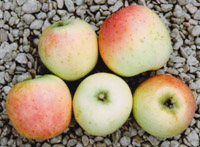 |
EDELBORSDORFER
The early written history of this apple is of Borsdorfer, which,
according to Bunyard, goes back to 1561. Queen Charlotte, wife of George
III, was so partial to the Borsdorfer apple, from her native land, that
she had a considerable quantity of them imported from Germany every year,
in the early 19th century. The first use of the term Edelborsdorfer was
by Berghuis in 1858, when he wrote the ‘de Nederlandsche Boomgard’
in Holland. Lucas and Oberdieck also used the name in 1875. It seems that
the name Edelborsdorfer was first noted in Britain when Bunyard, in ‘A
Handbook of Fruits’ in 1920, gave Edelborsdorfer as a synonym of
Borsdorfer. The prefix ‘Edel’ in German means something greater
or more noble and we suspect it was a later apple than Borsdorfer, which
we also have and which appears to be slightly different. We therefore
avoid the early history when talking about Edelborsdorfer. This is an
excellent apple, sweet and not as crisp as some but nevertheless rich
and tender, with white flesh. It is ripe here in late September and will
keep its moisture and flavour with careful storage, to the end of the
year if the weather is not too mild. Pollination Group 6 |
|||
 |
EDEN
A dessert apple that arose with E.J.Ingleby, of Forest & Orchard Nurseries,
at Falfield, Gloucestershire in 1948. It was introduced in 1957 by Matthews
Fruit Trees of Thurston, Bury St Edmunds, Suffolk. The National Apple
Register of 1971, and later writers, made this apple synonymous with Fon’s
Spring, but these two apples are distinct, though both came from the same
batch of seed arising from the crossing of John Standish with Cox’s
Orange Pippin, in the hands of Mr Ingleby. Eden is a regular, slightly
conical to round apple, with green to pale yellow skin, sometimes entirely
covered with deep pink, and then overlaid with a broad flush of deep carmine
and with crimson streaks. The flesh is crunchy rather than crisp, juicy,
sweet and with a pleasant, unusual flavour. It is ripe in late September
and October, keeping until the year end. The tree is a good bearer and
the fruit is attractive. Pollination Group 4 |
|||
|
||||